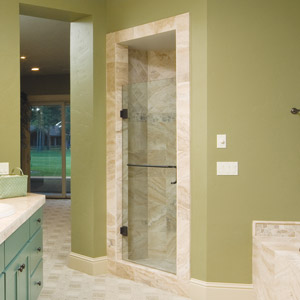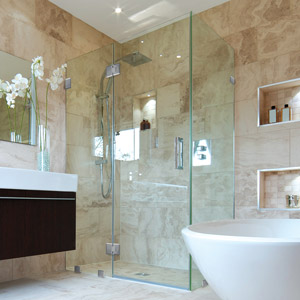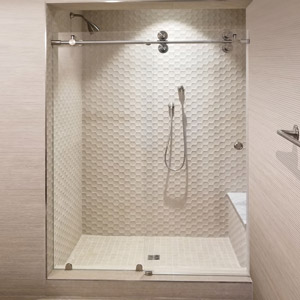Choosing the configuration of your new glass shower does not have to be based on guesswork or whim. Some bathroom designs automatically suggest or even require a particular configuration. In other cases, all options are practical, and you can choose any configuration that suits your practical and decorating needs.
The basic shower configurations include:
• Single door
• Inline door and panel
• 90 degree enclosure
• Neo-angle enclosure
• Rolling “barn style” doors
• Shower screen
One of the easiest ways to narrow down your options and make an informed choice is by scheduling a no-cost, no-obligation consultation with an ABC Glass and Mirror estimator. Meeting with a glass expert in the comfort of your home has several advantages over other methods of choosing a glass shower. For one thing, the glazier can give suggestions and information tailored to the shower area that he is inspecting and measuring. Also, you have the benefit of speaking to someone with years of experience in the glass field, and this can help you avoid costly mistakes or a finished product that’s difficult to clean or otherwise unsatisfactory. Now let’s take a closer look at each of the basic configurations.

Some showers – both large and compact – have a relatively narrow entrance that calls for either a single stall shower curtain or a glass door. A swinging glass door gives the shower room and the adjoining bathroom a high-end feel that a curtain cannot really provide. Using clear or ultra-clear glass for the door panel brightens the atmosphere inside the shower room and provides a view of the shower tile from the bathroom. For a more secluded shower experience, frosted or patterned glass is utilized instead.

At times, a shower area is already enclosed on three sides – this is often the case, for instance, when adding glass to a tub/shower combo. An inline door and panel configuration lends itself to this type of shower setup. A swinging glass door is installed along with one or more panels of fixed glass, all in line with each other to close off the shower stall. The inline configuration can be tailored to your bathroom layout and convenience in terms how the door and panel(s) are arranged and which side the door is hinged on. An inline shower enclosure can be installed on a shower curb or a tub deck.

On a 90 degree enclosure, there are typically two walls made of glass and two tiled walls. This popular corner shower style is similar to an inline shower enclosure, except that it has an additional glass panel, known as a 90 degree return, which is installed at a right angle to the adjoining glass wall and the tiled wall at the back of the shower. These enclosures can be personalized with regard to door size and placement as well as various other features.

A neo-angle configuration is another popular choice for corner showers. These usually have 3 glass walls – two fixed panels and a door in the middle – as well as two tiled walls that form a corner of the bathroom. On a neo-angle shower, glass panels adjoin each other at 135 degree angles for a look that works with traditional, transitional, and modern bathrooms. This configuration is also space-friendly and sometimes allows a homeowner to add a glass shower to an otherwise unused corner of a bathroom.

The configurations discussed so far have something in common – a swinging door. For bathrooms without much clearance around the shower entrance or homeowners who prefer a different look, frameless rolling shower doors are a fantastic option. These doors have a “barn style” operation, hanging from and rolling along a bar that extends across the top of the shower. Available variations include:
• One door that rolls past a fixed panel.
• Two rolling door panels.
• Metal header on which the doors roll.
• Glass header on which the doors roll.
These doors really pop in farmhouse and industrial style bathrooms, but their look is so sleek and classic that it enhances bathrooms of any style.

Shower screens are fixed glass panels used to create walk-in showers. These door-less shower stalls feature an open entryway, and water management is maintained through appropriate floor slope, a carefully situated drain, and thoughtfully placed shower sprays. Walk-in showers vary greatly in size, design, and amount of glass. Examples include:
• A glass shower that is enclosed on three sides with the fourth left open as an entrance.
• A wet room for both shower and tub that is separated from the rest of the bathroom by a single glass panel.
• Two parallel glass panels with the remaining two sides left open.
Walk-in showers are often curb-less to boost the accessibility of this already user-friendly shower style.
You can build your own virtual dream shower on our website and try these different configurations to get a better idea of the shower design that’s right for your bathroom. In addition to these popular styles, there are more shower options such as double swinging doors, steam enclosures, and semi-frameless bypass doors. Call ABC Glass and Mirror at (703)257-7150 for more info and to reserve your time slot for a free in-home consultation!